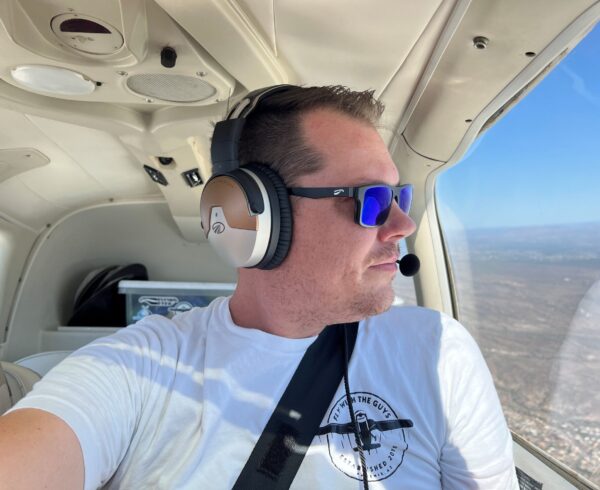Meet Jolie Lucas. She lives on the Central Coast of California with her mini-Golden, Mooney. Jolie is a Mooney owner, licensed psychotherapist, and now a commercial pilot. This is part of her story of continuing to chase her dreams in aviation and how to achieve great things, even during a global pandemic…
My life has always been in and around aviation – my Father was an Army Air Corps trainer flying the Boeing Stearman in World War II and flew the family around the country for vacations, aviation events and reunions.
In late 2017 I earned my instrument rating after training in the LA Basin. My logic was that if you can get your instrument ticket in one of the world’s busiest airspaces, you might learn a thing or two. Living on the Central California coast I have used the instrument ticket frequently to get through and over our coastal fog. Flights to and from EAA Air Venture in Oshkosh, WI in 2018 and 2019 also relied heavily on the precision of instrument flying due to weather and smoke.

Over the years I had a few opportunities to fly for pay but didn’t have the certificate. So, in 2019 I began to work on my Commercial certificate (many think it is a rating). Flying to and from Texas with my CFI gave me a lot of the dual cross-country time that was required. At the beginning it was a struggle to understand some of the terms such as private carriage, common carriage, and holding out. The Commercial flying itself was similar to VFR flight until I started learning the required maneuvers laid out in the Airman Certification Standards (ACS). I passed the written in January of 2020 thinking that by the end of March I would be ready for my check ride. Well, we all know what happened in March of 2020.
Flight training in times of COVID-19
For many of us, life while quarantined or under stay-at-home orders was very disorienting. Pilots are typically “do something” people. We have checklists, procedures, flight plans and destinations. Personally, it felt very strange to be working even more than usual, but all my “play” was cancelled. In these times, my advice is to pick an aviation goal, like a new certificate or rating, and develop a timeline towards attaining it.
Flying to commercial standards is all about smoothness, precision, and planning for passengers. Training was intense and consisted of the learning and demonstration of the elements included in the ACS. Many told me that I would love flying the fun commercial maneuvers (chandelle, steep spiral, lazy 8, 180 power off landing, steep turns, 8s on pylons etc.). I didn’t really experience the “fun” part of it until the very last day of training. As I was demonstrating elements for my check ride prep, I found myself zooming down during a lazy 8 and thought, “Yeah, this is fun being totally in control of this airplane.”
Thinking like a Pro-Pilot
As I prepared for check ride, there was a distinct change in my thought process toward what I call, “Pro-Pilot” thinking. My Designated Pilot Examiner (DPE) gave me the following cross-country scenario:
So much for an easy fire season– lightning has sparked a big wind-driven fire over by Sandpoint, ID, causing a bit of a panic. Newly hired by a Part 135 group that has extensive Forest Service contracts, you have been tasked to fly two Incident Commanders from your base, The Dalles OR (KDLS), to the Sandpoint airport (KSZT) in your aircraft, where they will join the hastily assembled Hot Shot crews waiting to take on the fire. You have recently noticed that your turn coordinator has been really noisy on startup, but you have not had an opportunity to have it checked out. The firefighters think they weigh around 180lbs and plan on taking roughly 60lbs of gear each. They really need to be in Sandpoint by noon, so plan accordingly.
As a private pilot you would of course think about inoperative equipment, weight, fuel, weather, and routing, but as a Pro Pilot I planned around:
- Passenger comfort
- Loading of passengers/bags for CG
- Prevailing weather, wind, smoke conditions
- Instrument currency/approaches if needed
- Route with less potential for turbulence
- Route near airports/highways
- Alternate airports with rental cars, calculate driving distance
- Timing details to get the firefighters to Sandpoint by noon
A commercial pilot must have good communication with passengers ahead of the flight and the ability to make great decisions in the planning and execution of the flight. I put in 3.0 hours of planning for the 1.5-hour flight from KDLS to KSZT. This was prep for a check ride, but I believe that for many commercial flights the planning and prep will often be longer than the flight leg.
I decided that attaining the Commercial would further my skills and prepare me for opportunities to fly differently. Now I have the ability to be paid to move aircraft from one part of the country to another, fly a business person (in a company airplane) to meetings, fly charter, jump planes, banner towing, or even offer sightseeing tours in my home area. The certificate is the key to moving up the ranks in the pilot world.

Getting the Commercial certificate was a great accomplishment after many months of training and study. Experiencing first-hand the mind shift to Pro-Pilot thinking was very gratifying. I would recommend any pilot who would like to step up their skill set to pursue the Commercial. Now I am focused on the multi-engine Commercial rating in late September. While these times are certainly challenging, having additional ratings and certificates can lead to some fun opportunities and getting paid to go flying.
The Commercial certificate is all about the artistry of flight and demonstrating your stick and rudder skills to paying passengers. I highly recommend any pilot who would like to step-up their skill set to pursue the Commercial.















Okay, gotta ask about the picture with the Bellanca Cruisair Sr. Was it previously owned by Rick Arnold and based at a Torrance Airport circa 1983?
Have a picture of it in one of my albums taken when I was a Student Pilot at Torrance.